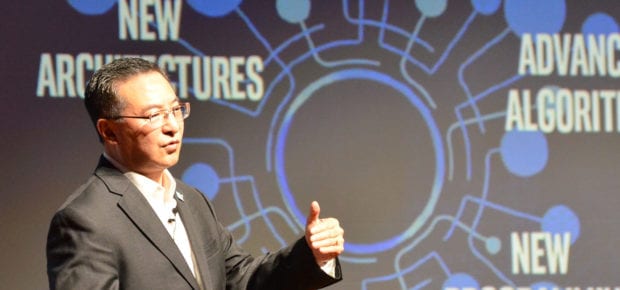December 20, 2019
The IEEE GLOBECOM 2019 conference in Waikoloa, HI, brought together nearly 3,000 attendees with a focus on building next-generation networks. IEEE Senior Member Geng Wu, an Intel Fellow and chief technologist for wireless technologies and standards at Intel Corporation, delivered a keynote address on “Future Generation Mobile Connected Intelligence.” He described how future networks must be architected for data efficiency, flexibility and service.
The nature of data is constantly changing. Over the past 10 years, we saw an increase in social media and video-streaming traffic. In the next 10 years, we are likely to see more client-generated media, such as video surveillance services, machine-to-machine communications and metadata about the services that we are using. Wu explains that as networks evolve and become no longer restricted to only humans, the nature of data and types of communication are going to reshape mobile computing.
Two Challenges of Next Generation Mobile Computing
Wu segments the challenges for the next generation of mobile computing into two areas. First, the complexity of developing modern systems-on-chip is dominated by software, validation, physical implementation and IP qualification challenges. Second, future networks have new use cases such as roadside units and robots, and changing topologies such as drone clusters or autonomous vehicles.
“Tackling these challenges will require a systems view,” says Wu. “We need to holistically consider data, computing and communication in order to build scalable, secure and efficient networks.”
According to Wu, “security is key; one way to address it is to have an open network architecture and implementation.” Wu proposes multiple ways to impose security at the application, network and platform layers in next-generation networks.
First, we must implement protocols to locally share, process and distribute data between devices and the network. Second, we can implement blockchain in the radio-access and core networks to ensure trusted data sharing across security domains.
See also How to Design Ethical, Resilient and Secure IoT Software, According to Google’s Vint Cerf
What is the Future of Next Generation Networks?
Wu believes that future networks must also be designed with AI in mind. To do so, “we need to create new fundamentals so that multiple AI systems can work together,” explains Wu. “Machine learning is moving from offline, to near real-time, to dynamic. We can leverage AI to design systems with many dimensions, however, AI data can be misleading; how do we determine which data is meaningful, and remove the data that might be downgrading performance?”
When asked how the end of Moore’s Law will impact next-generation networks, Wu pointed out that 3D packaging technology and silicon photonics will help to overcome semiconductor scaling challenges in the near term.
In the long term, Wu predicts that breakthroughs in materials and computing algorithms will continue to drive innovation. Wu notes that this will require collaboration across universities, governments and industries, as well as research in new computing models such as quantum computing.
About our author
Mario Milicevic is an IEEE Member and Staff Communication Systems Engineer at MaxLinear.






 AI Through Our Ages
AI Through Our Ages Liquid Infrastructure: Our Planet's Most Precious Resource
Liquid Infrastructure: Our Planet's Most Precious Resource The Impact of Technology in 2025
The Impact of Technology in 2025 Quantum and AI: Safeguards or Threats to Cybersecurity?
Quantum and AI: Safeguards or Threats to Cybersecurity? Why AI Can't Live Without Us
Why AI Can't Live Without Us Bits, Bytes, Buildings and Bridges: Digital-Driven Infrastructure
Bits, Bytes, Buildings and Bridges: Digital-Driven Infrastructure Impact of Technology in 2024
Impact of Technology in 2024 Emerging AI Cybersecurity Challenges and Solutions
Emerging AI Cybersecurity Challenges and Solutions The Skies are Unlimited
The Skies are Unlimited Smart Cities 2030: How Tech is Reshaping Urbanscapes
Smart Cities 2030: How Tech is Reshaping Urbanscapes Impact of Technology 2023
Impact of Technology 2023 Cybersecurity for Life-Changing Innovations
Cybersecurity for Life-Changing Innovations Smarter Wearables Healthier Life
Smarter Wearables Healthier Life Infrastructure In Motion
Infrastructure In Motion The Impact of Tech in 2022 and Beyond
The Impact of Tech in 2022 and Beyond Cybersecurity, Technology and Protecting Our World
Cybersecurity, Technology and Protecting Our World How Technology Helps us Understand Our Health and Wellness
How Technology Helps us Understand Our Health and Wellness The Resilience of Humanity
The Resilience of Humanity Harnessing and Sustaining our Natural Resources
Harnessing and Sustaining our Natural Resources Creating Healthy Spaces Through Technology
Creating Healthy Spaces Through Technology Exceptional Infrastructure Challenges, Technology and Humanity
Exceptional Infrastructure Challenges, Technology and Humanity The Global Impact of IEEE's 802 Standards
The Global Impact of IEEE's 802 Standards Scenes of our Cyber Lives: The Security Threats and Technology Solutions Protecting Us
Scenes of our Cyber Lives: The Security Threats and Technology Solutions Protecting Us How Millennial Parents are Embracing Health and Wellness Technologies for Their Generation Alpha Kids
How Millennial Parents are Embracing Health and Wellness Technologies for Their Generation Alpha Kids Space Exploration, Technology and Our Lives
Space Exploration, Technology and Our Lives Global Innovation and the Environment
Global Innovation and the Environment How Technology, Privacy and Security are Changing Each Other (And Us)
How Technology, Privacy and Security are Changing Each Other (And Us) Find us in booth 31506, LVCC South Hall 3 and experience the Technology Moon Walk
Find us in booth 31506, LVCC South Hall 3 and experience the Technology Moon Walk Virtual and Mixed Reality
Virtual and Mixed Reality How Robots are Improving our Health
How Robots are Improving our Health IEEE Experts and the Robots They are Teaching
IEEE Experts and the Robots They are Teaching See how millennial parents around the world see AI impacting the lives of their tech-infused offspring
See how millennial parents around the world see AI impacting the lives of their tech-infused offspring Take the journey from farm to table and learn how IoT will help us reach the rising demand for food production
Take the journey from farm to table and learn how IoT will help us reach the rising demand for food production Watch technical experts discuss the latest cyber threats
Watch technical experts discuss the latest cyber threats Explore how researchers, teachers, explorers, healthcare and medical professionals use immersive technologies
Explore how researchers, teachers, explorers, healthcare and medical professionals use immersive technologies Follow the timeline to see how Generation AI will be impacted by technology
Follow the timeline to see how Generation AI will be impacted by technology Learn how your IoT data can be used by experiencing a day in a connected life
Learn how your IoT data can be used by experiencing a day in a connected life Listen to technical experts discuss the biggest security threats today
Listen to technical experts discuss the biggest security threats today See how tech has influenced and evolved with the Games
See how tech has influenced and evolved with the Games Enter our virtual home to explore the IoT (Internet of Things) technologies
Enter our virtual home to explore the IoT (Internet of Things) technologies Explore an interactive map showcasing exciting innovations in robotics
Explore an interactive map showcasing exciting innovations in robotics Interactively explore A.I. in recent Hollywood movies
Interactively explore A.I. in recent Hollywood movies Get immersed in technologies that will improve patients' lives
Get immersed in technologies that will improve patients' lives